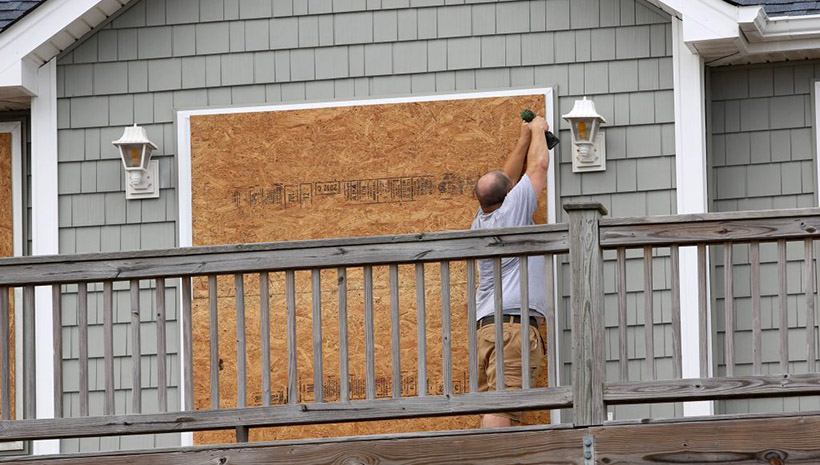A Constitutional Republic, where the First Amendment is Essential to OUR Survival
Shifting Sands: We Continue to Build and Live Along the N.C. Coast, but Should We?
Publisher's note: This post appears here courtesy of the Carolina Journal, and written by Lindsay Marchello.

Coastal communities are no strangers to the heavy winds and the massive storm surges hurricanes bring.
Hurricane Dorian was no different when it hammered North Carolina's barrier islands at the start of September.
The people are resilient. They will rebuild, as they always do, after each hurricane.
But should they?
That's the question local officials should be asking, a professor specializing in shoreline management says.
Rob Young, a geology professor at Western Carolina University and director of the Program for the Study of Developed Shorelines, is ringing the alarm on coastal development.
"Hurricane Dorian caused the most geomorphological change on any barrier island in my 30-year career," Young said during a Sept. 17 Crucial Conversations event sponsored by N.C. PolicyWatch.
While breaches on the coast aren't uncommon, and inlets come and go, Young said Dorian's effect on the coast was unprecedented. Dorian overwashed massive amounts of sand, and some of the breaches may persist.
"I fear we have reached some sort of threshold here on Cape Lookout that has changed the regime of this island," Young said. "There's just not as much sand as there used to be."
Young said Cape Lookout may be sending a message to all North Carolina's barrier islands.
It's time to talk about managed retreat from the coast, the WCU professor said. Instead of repeatedly rebuilding on the coast after each storm, Young proposes the government buy properties in high-risk zones and demolish them, allowing the coast to revert to its natural state. Coastal properties are at risk of flooding from storm surges and are made even more vulnerable by beach erosion.
In a recent study focused on North Topsail Beach, the Program for the Study of Developed Shorelines identified about 400 properties that could qualify for a targeted acquisition program.
"This should be a tool in this toolbox regarding managing the coast," Young said. "This is not a crazy idea. This is something that needs to be examined every time we do a coastal protection project."
State and local officials need to start considering managed retreat, Young said, as constantly rebuilding the coast through beach-nourishment projects and by elevating properties with Hazard Mitigation Grants isn't sustainable.
"No, Professor Young, there will be no retreat from our homes - no retreat from the coast," McElraft said.
McElraft, who represents a district composed of coastal communities, said the state and local governments have taken good care of the beaches and, in turn, they continue to be one of the state's greatest assets.
"Had we not kept up our healthy beaches, we may have had a few homes engulfed by the ocean," McElraft said. "But we have kept up the maintenance of these public trust beaches, mostly at local taxpayer expense."
Part of that maintenance includes beach nourishment, a process that sees tons of sand sucked from the ocean and dumped on the beach to replenish what's lost. Across the country, billions have been spent on nourishment projects.
Again, with taxpayers footing the bill.
Young says it would be more cost-effective for the government to ditch beach-nourishment projects and instead buy properties along the coast. In the Program for the Study of Developed Shorelines report, North Topsail Beach could save some $2.8 million if it implemented targeted acquisitions, instead of investing in beach-renourishment projects. The report estimates the buyout program would cost $54.8 million - compared to the $57.6-million cost of future coast stabilization projects and sandbag maintenance. This assumes the properties are purchased at their full assessed values.
But Young sees other unquantifiable benefits to employing a managed retreat approach. Municipalities could redirect resources to a larger part of the community that isn't in a high-risk zone. For North Topsail Beach, managed retreat would shift the focus away from 7% of the tax base to the other 93%. Additionally, the local ecosystem could flourish in the absence of beach-nourishment projects and other artificial coastal protections
Canada, for instance, has started to take the approach that, if you choose to build in a high-risk zone, then you're on your own when it comes to recovering after a storm.
"If people deliberately rebuild in danger zones, at some point, "they are going to have to assume their own responsibility for the cost burden," Ralph Goodale, the Canadian public security minister, said, as reported by WRAL. "You can't repeatedly go back to the taxpayer and say, 'Oh, it happened again.'"
J. Lehmann is a senior fellow at R Street, a nonprofit, nonpartisan, public policy research organization. Lehmann says people need to understand the full risk of developing in high-risk zones, such as on the coast or in floodplains. Government insurance programs, such as the National Flood Insurance Program and the state's Beach Plan, can distort risk for property owners.
When the market is able to fully consider risk, the price will signal whether building in certain areas is worth it, Lehmann said.
"I think we get a little ahead of ourselves when we talk about retreat. The first thing we have to do is stop providing incentives to build in those places in the first place," Lehmann said. "First, do no harm. Then, we can move on to the next phase of what to do with people who are there now."
The availability of coverage with the National Flood Insurance Program, zoning and land use regulations that don't acknowledge the level of risk, as well as outdated flood maps, contribute to the perception that certain places are safe for development. North Carolina's flood maps are up to date, but, Lehmann said, developers don't always consider them when deciding where to build.
"There are any number of tools that will have to be implemented to deal with this problem," Lehmann said. "I prefer using those tools that align the market with the proper incentives, so if the market can accommodate risk through insurance and incentives to build stronger and more resilient structures, that is always going to be the preference.
"There are some communities that have multiple, repetitive, severe losses that should be targeted for some kind of change, whether that's buyouts or mitigation," Lehmann said. "But you have to be cautious. It's a powerful tool, and the government shouldn't use it recklessly. It should be used wisely."
The Natural Resources Defense Council estimates more than 36,000 buildings across the U.S. are subject to repeated flooding. Of those buildings, 10,000 are in North Carolina.
Laura Hogshead, director of the Office of Recovery and Resiliency, said targeted acquisitions are just one of many ways the state is working to prepare people for future natural disasters.
The Office of Recovery and Resiliency was created in 2018 to streamline the process of getting disaster relief to affected communities.
"The Office of Recovery and Resiliency is working towards streamlining all the programs, including becoming the official grantee for the HUD funds," Hogshead said. "One of the most significant things we have been able to do in the last few months is to be recognized by HUD as the grantee for these funds."
Hogshead said her office is reviewing the processes and procedures to ensure they comply with federal and state law, while at the same time keeping an eye on expediency.
Mike Sprayberry, director of N.C. Emergency Management, said the state is learning ways to better deliver relief after each and every hurricane.
"I came here in 2005, and I can tell you we are a lot farther ahead than we have been. Our programs are a lot bigger, too," Sprayberry said.
The NCEM director said the state has already spent more than $2.8 billion on relief efforts after Hurricanes Matthew in 2016 and Hurricane Florence last year, including money from Federal Emergency Management Agency Hazard Mitigation grant program.
Through the Hazard Mitigation Grant program, properties can either be elevated to withstand future flooding - or they can be acquired. Depending on the severity of the damage, properties can either be relocated - or demolished. Money from the U.S. Department of Housing and Urban Development's Community Development Block Grant Disaster Recovery program can also be used for a buyout program.
Some North Carolina properties have already been approved for buyouts with disaster-relief money. In 2018, NCEM and FEMA awarded $88.1 million in Hazard Mitigation Grants to local governments for Matthew. On Aug. 16, North Carolina and FEMA approved $19 million to acquire 130 residential structures in natural floodplains after Hurricane Florence. On Aug. 29, $4.1 million was awarded to acquire 25 flood-prone properties in Pender County. Properties approved for buyouts will be converted into open spaces.
"We are doing a lot of buyouts, hundreds in fact, and we are doing elevations," Sprayberry said. "That's how we make sure we are getting people out of places with repetitive flooding."
Hogshead said priority zones for buyouts are mapped using data-driven methods.
"The priority zones for buyouts were mapped with all previous storms. When you lay everything out on a map together with where there has been severe repetitive loss, where there have been FEMA applications, where there have been HUD applications, the hotspots really pop out," Hogshead said. "We are focusing on those areas.
"We give all the information that we have to the homeowner. It's the homeowner's choice," Hogshead said. "We are talking with communities and homeowners very strongly about the fact that the storms are coming more frequently."
When the state gets money from HUD for Hurricane Florence, Hogshead said, it will offer buyouts in coastal communities.
While managed retreat has gained traction when addressing development in flood plains, Young said, the same can't be said for coastal development. Coastal communities are reluctant to leave prime beachfront property. But, Young said, people don't have to entirely abandon the coast.
"The reason you do this is to protect your coastal economy and protect your community," Young said. "You do that by taking a little step back from one hotspot where there's erosion and focusing all your energy and resources on the parts of your community that are sustainable."
Editor's note: This story was corrected after publication. The cost estimates of purchasing land versus renourishing the beach communities was reversed. We regret the error.
Go Back

A resident of Topsail Beach protects his home. | Photo: Don Carrington/Carolina Journal
Coastal communities are no strangers to the heavy winds and the massive storm surges hurricanes bring.
Hurricane Dorian was no different when it hammered North Carolina's barrier islands at the start of September.
The people are resilient. They will rebuild, as they always do, after each hurricane.
But should they?
That's the question local officials should be asking, a professor specializing in shoreline management says.
Rob Young, a geology professor at Western Carolina University and director of the Program for the Study of Developed Shorelines, is ringing the alarm on coastal development.
"Hurricane Dorian caused the most geomorphological change on any barrier island in my 30-year career," Young said during a Sept. 17 Crucial Conversations event sponsored by N.C. PolicyWatch.
While breaches on the coast aren't uncommon, and inlets come and go, Young said Dorian's effect on the coast was unprecedented. Dorian overwashed massive amounts of sand, and some of the breaches may persist.
"I fear we have reached some sort of threshold here on Cape Lookout that has changed the regime of this island," Young said. "There's just not as much sand as there used to be."
Young said Cape Lookout may be sending a message to all North Carolina's barrier islands.
It's time to talk about managed retreat from the coast, the WCU professor said. Instead of repeatedly rebuilding on the coast after each storm, Young proposes the government buy properties in high-risk zones and demolish them, allowing the coast to revert to its natural state. Coastal properties are at risk of flooding from storm surges and are made even more vulnerable by beach erosion.
In a recent study focused on North Topsail Beach, the Program for the Study of Developed Shorelines identified about 400 properties that could qualify for a targeted acquisition program.
"This should be a tool in this toolbox regarding managing the coast," Young said. "This is not a crazy idea. This is something that needs to be examined every time we do a coastal protection project."
State and local officials need to start considering managed retreat, Young said, as constantly rebuilding the coast through beach-nourishment projects and by elevating properties with Hazard Mitigation Grants isn't sustainable.
Not happening
That's ridiculous, Rep. Pat McElraft, R-Carteret, said."No, Professor Young, there will be no retreat from our homes - no retreat from the coast," McElraft said.
McElraft, who represents a district composed of coastal communities, said the state and local governments have taken good care of the beaches and, in turn, they continue to be one of the state's greatest assets.
"Had we not kept up our healthy beaches, we may have had a few homes engulfed by the ocean," McElraft said. "But we have kept up the maintenance of these public trust beaches, mostly at local taxpayer expense."
Part of that maintenance includes beach nourishment, a process that sees tons of sand sucked from the ocean and dumped on the beach to replenish what's lost. Across the country, billions have been spent on nourishment projects.
Again, with taxpayers footing the bill.
Young says it would be more cost-effective for the government to ditch beach-nourishment projects and instead buy properties along the coast. In the Program for the Study of Developed Shorelines report, North Topsail Beach could save some $2.8 million if it implemented targeted acquisitions, instead of investing in beach-renourishment projects. The report estimates the buyout program would cost $54.8 million - compared to the $57.6-million cost of future coast stabilization projects and sandbag maintenance. This assumes the properties are purchased at their full assessed values.
But Young sees other unquantifiable benefits to employing a managed retreat approach. Municipalities could redirect resources to a larger part of the community that isn't in a high-risk zone. For North Topsail Beach, managed retreat would shift the focus away from 7% of the tax base to the other 93%. Additionally, the local ecosystem could flourish in the absence of beach-nourishment projects and other artificial coastal protections
Flood plains versus coastlines
Managed retreat isn't a completely new approach to managing disasters. Targeted acquisitions aren't uncommon for communities that lie in flood plains.Canada, for instance, has started to take the approach that, if you choose to build in a high-risk zone, then you're on your own when it comes to recovering after a storm.
"If people deliberately rebuild in danger zones, at some point, "they are going to have to assume their own responsibility for the cost burden," Ralph Goodale, the Canadian public security minister, said, as reported by WRAL. "You can't repeatedly go back to the taxpayer and say, 'Oh, it happened again.'"
J. Lehmann is a senior fellow at R Street, a nonprofit, nonpartisan, public policy research organization. Lehmann says people need to understand the full risk of developing in high-risk zones, such as on the coast or in floodplains. Government insurance programs, such as the National Flood Insurance Program and the state's Beach Plan, can distort risk for property owners.
When the market is able to fully consider risk, the price will signal whether building in certain areas is worth it, Lehmann said.
"I think we get a little ahead of ourselves when we talk about retreat. The first thing we have to do is stop providing incentives to build in those places in the first place," Lehmann said. "First, do no harm. Then, we can move on to the next phase of what to do with people who are there now."
The availability of coverage with the National Flood Insurance Program, zoning and land use regulations that don't acknowledge the level of risk, as well as outdated flood maps, contribute to the perception that certain places are safe for development. North Carolina's flood maps are up to date, but, Lehmann said, developers don't always consider them when deciding where to build.
Options other than retreat
Managed retreat should be an option, the R Street senior fellow said, but the government should also consider other mitigation efforts - building sea walls, elevating properties above the flood elevation level, and constructing dams or levees."There are any number of tools that will have to be implemented to deal with this problem," Lehmann said. "I prefer using those tools that align the market with the proper incentives, so if the market can accommodate risk through insurance and incentives to build stronger and more resilient structures, that is always going to be the preference.
"There are some communities that have multiple, repetitive, severe losses that should be targeted for some kind of change, whether that's buyouts or mitigation," Lehmann said. "But you have to be cautious. It's a powerful tool, and the government shouldn't use it recklessly. It should be used wisely."
The Natural Resources Defense Council estimates more than 36,000 buildings across the U.S. are subject to repeated flooding. Of those buildings, 10,000 are in North Carolina.
Laura Hogshead, director of the Office of Recovery and Resiliency, said targeted acquisitions are just one of many ways the state is working to prepare people for future natural disasters.
The Office of Recovery and Resiliency was created in 2018 to streamline the process of getting disaster relief to affected communities.
"The Office of Recovery and Resiliency is working towards streamlining all the programs, including becoming the official grantee for the HUD funds," Hogshead said. "One of the most significant things we have been able to do in the last few months is to be recognized by HUD as the grantee for these funds."
Hogshead said her office is reviewing the processes and procedures to ensure they comply with federal and state law, while at the same time keeping an eye on expediency.
Mike Sprayberry, director of N.C. Emergency Management, said the state is learning ways to better deliver relief after each and every hurricane.
"I came here in 2005, and I can tell you we are a lot farther ahead than we have been. Our programs are a lot bigger, too," Sprayberry said.
The NCEM director said the state has already spent more than $2.8 billion on relief efforts after Hurricanes Matthew in 2016 and Hurricane Florence last year, including money from Federal Emergency Management Agency Hazard Mitigation grant program.
Through the Hazard Mitigation Grant program, properties can either be elevated to withstand future flooding - or they can be acquired. Depending on the severity of the damage, properties can either be relocated - or demolished. Money from the U.S. Department of Housing and Urban Development's Community Development Block Grant Disaster Recovery program can also be used for a buyout program.
Some North Carolina properties have already been approved for buyouts with disaster-relief money. In 2018, NCEM and FEMA awarded $88.1 million in Hazard Mitigation Grants to local governments for Matthew. On Aug. 16, North Carolina and FEMA approved $19 million to acquire 130 residential structures in natural floodplains after Hurricane Florence. On Aug. 29, $4.1 million was awarded to acquire 25 flood-prone properties in Pender County. Properties approved for buyouts will be converted into open spaces.
"We are doing a lot of buyouts, hundreds in fact, and we are doing elevations," Sprayberry said. "That's how we make sure we are getting people out of places with repetitive flooding."
Hogshead said priority zones for buyouts are mapped using data-driven methods.
"The priority zones for buyouts were mapped with all previous storms. When you lay everything out on a map together with where there has been severe repetitive loss, where there have been FEMA applications, where there have been HUD applications, the hotspots really pop out," Hogshead said. "We are focusing on those areas.
"We give all the information that we have to the homeowner. It's the homeowner's choice," Hogshead said. "We are talking with communities and homeowners very strongly about the fact that the storms are coming more frequently."
When the state gets money from HUD for Hurricane Florence, Hogshead said, it will offer buyouts in coastal communities.
While managed retreat has gained traction when addressing development in flood plains, Young said, the same can't be said for coastal development. Coastal communities are reluctant to leave prime beachfront property. But, Young said, people don't have to entirely abandon the coast.
"The reason you do this is to protect your coastal economy and protect your community," Young said. "You do that by taking a little step back from one hotspot where there's erosion and focusing all your energy and resources on the parts of your community that are sustainable."
Editor's note: This story was corrected after publication. The cost estimates of purchasing land versus renourishing the beach communities was reversed. We regret the error.
| Trump's New Approach to Congress: Hardball with GOP | Carolina Journal, Editorials, Op-Ed & Politics | Pols Should Accept Urban Realities |
























